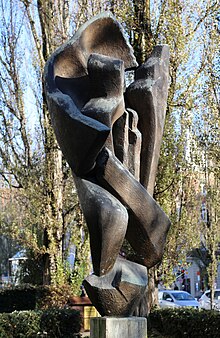Raoul Ratnowsky
Raoul Ratnowsky (born July 10, 1912 in Zurich ; † August 2, 1999 in Arlesheim ) was a Swiss sculptor .
Life
Raoul Ratnowsky was the son of Russian immigrants, the father came from the Caucasus, the mother from the Volga, in Switzerland. At the age of four, the family moved to Küsnacht in the canton of Zurich, where Ratnowsky spent his childhood. In 1925 the family moved to Winterthur . There he attended high school. After finishing school, Ratnowsky worked as an art critic for a newspaper for a year . After that he turned to sculpture and took lessons from various sculptors. He exhibited for the first time in 1933. A subsequent scholarship took him to Rome and Florence, and later to Paris and Chartres .
From 1934 Ratnowsky had his own studios in St. Gallen and Zurich. In 1937 he met the poet Albert Steffen , from whom he received many suggestions for further artistic work and whom he later modeled. Many art trips abroad followed in the 1940s. During this time Ratnowsky changed his artistic expression from the figurative to more and more free forms. In 1952 he took over the management of the plasticizing school at the Goetheanum in Dornach near Basel, where he initiated training as a sculptor and craft teacher.
Raoul Ratnowsky received his first order for a large sculpture in 1956. It was set up at the Zervreila reservoir in the Graubünden Alps at an altitude of 1000 meters. With this work, the artist took a completely new step in sculptural design, with which he placed large, expansive areas in the context of the natural environment. The 4.40 meter high sculpture was intended by Ratnowsky as a kind of protective motif for a valley that had undergone a major encroachment on the structure of its life as a result of the construction of the power station.
A friendship developed from the meeting with Hermann Abele in 1956, which led to years of collaboration. In 1965 Abele gave his friend the new building for a large studio. Further orders for large-scale sculptures in public spaces, many of them in busy places in large cities or in social housing, followed in Munich, Bad Godesberg, Frankfurt, Stuttgart and Berlin. In addition to his work, numerous exhibitions have taken place in various European cities.
After Mia Rist and his long-time colleague Elke Dominik took over the management of the plastic school at the Goetheanum at the end of the 1970s, Ratnowsky was able to devote himself to developing a plastic-therapeutic course. In the course of this, he and Hermann Abele founded the Raoul Radnowsky-Hermann Abele Foundation . With it, a place was created where, in addition to seminars for various artistic directions and exhibitions, pedagogy and artistic therapies were to be cultivated and further developed.
Work and reception
In his early years Ratnowsky mainly worked with wood and stone, working them with an ax or chisel, later he preferred materials such as bronze , aluminum or concrete . While his early wooden sculptures were kept in gentle, soft forms, his later bronzes and large sculptures gave the impression that the artist had to prove that nothing can withstand the living, creative force.
For Ratnowsky, the process of design is not only the transition from two-dimensionality to three-dimensionality, but also the examination of the particularity of the material and the overcoming of gravity. In many of his works, burdensome masses pile up on slender substructures. The double-curved surfaces give lightness to heaviness.
Raoul Ratnowsky's art is modern and contemporary. In it the artist is less concerned with the depiction of the physical, but rather with the experience of its spiritual references. It opens up in tranquility and meditative experience.
literature
- Raoul Radnowsky . Sculptures, models, sketches, aphorisms. With texts by Johannes Anderegg and Inge Thöns. Urachhaus Stuttgart publishing house, 1979, ISBN 3-87838-267-7
Individual evidence
- ↑ Raoul Ratnowsky , pp. 161-163.
- ↑ Plastic School, Goetheanum
- ↑ Culture impulse
- ↑ Inge Thöns in: Raoul Ratnowsky , p. 12
- ↑ Johannes Anderegg in: Raoul Radnowsky , p. 7/8
Web links
- Plastic school at the Goetheanum
- Sonnengarten (PDF; 3.2 MB)
- sculpture
- sculpture
| personal data | |
|---|---|
| SURNAME | Ratnowsky, Raoul |
| BRIEF DESCRIPTION | Swiss sculptor |
| DATE OF BIRTH | July 10, 1912 |
| PLACE OF BIRTH | Zurich , Switzerland |
| DATE OF DEATH | August 2, 1999 |
| Place of death | Arlesheim |



